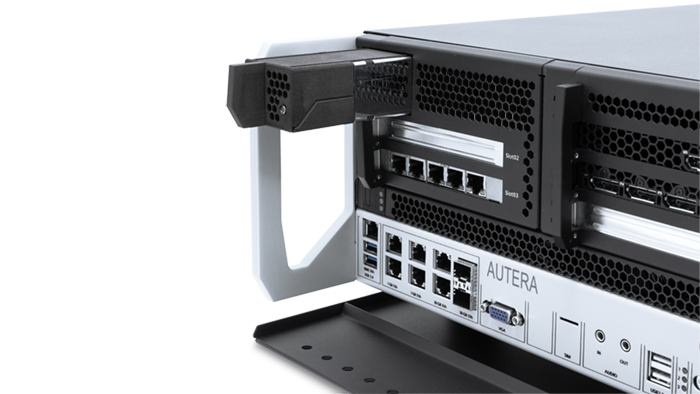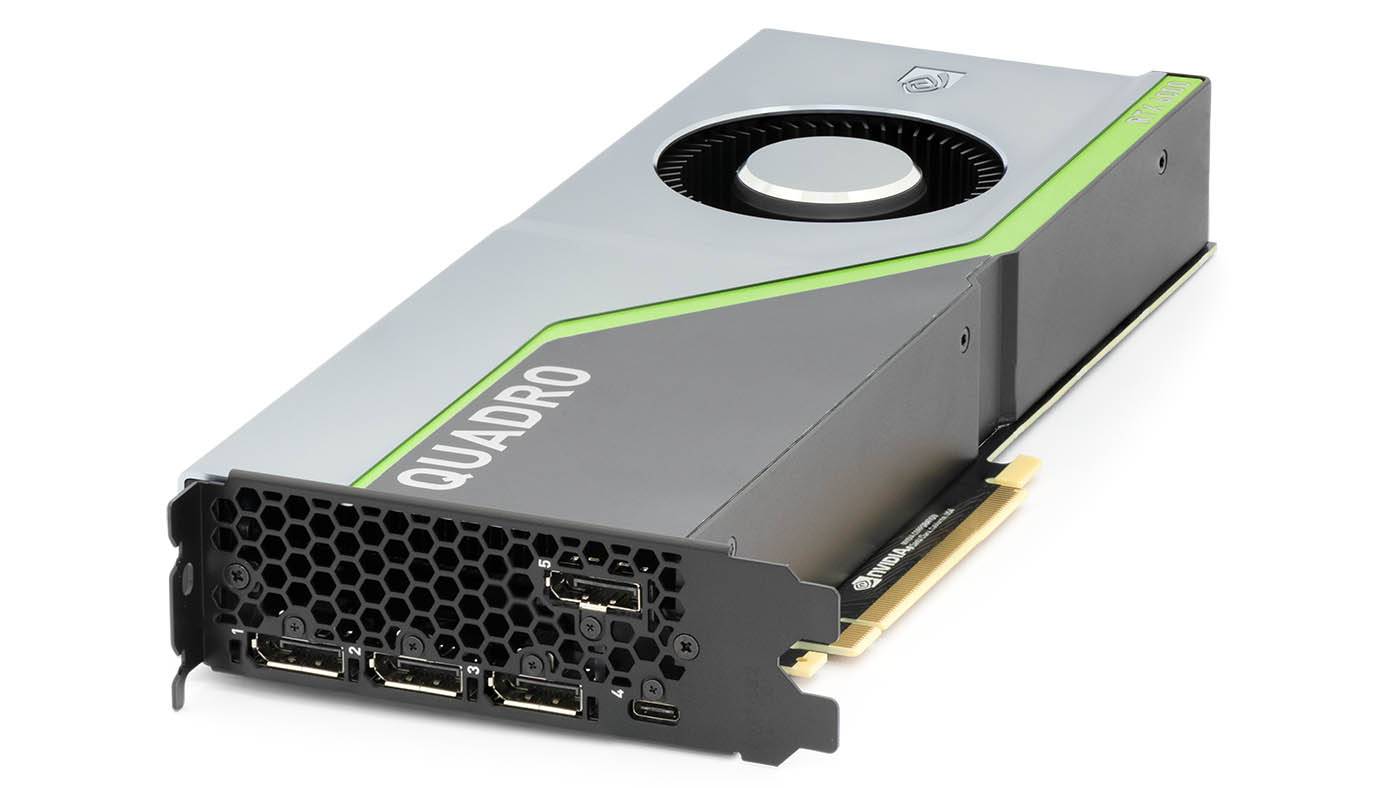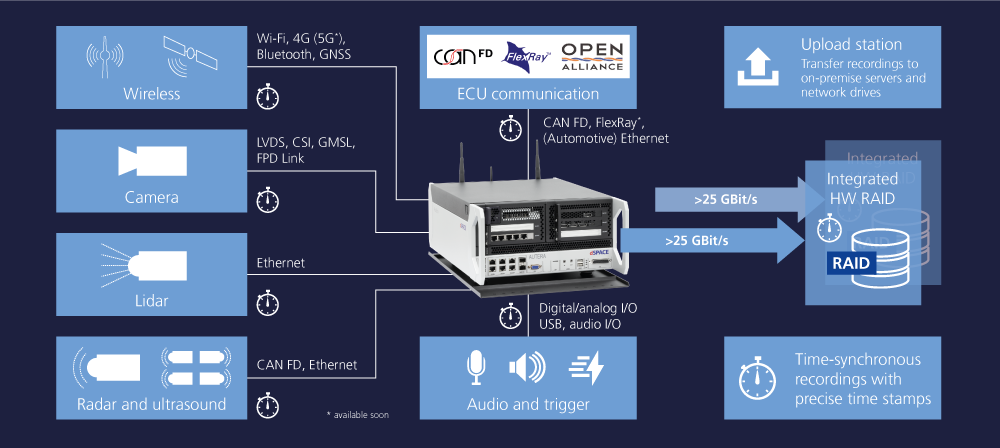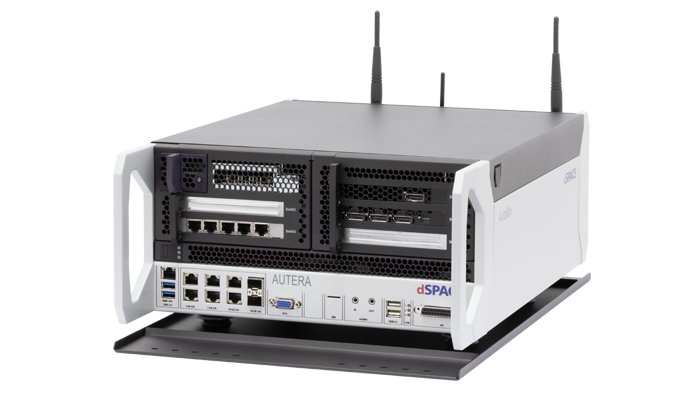Environment perception sensors are critically important to the operation of autonomous vehicles. These sensors generate ever growing volumes of data. With the AUTERA product family, dSPACE now offers a system that can read, process, and record raw sensor data from lidar, radar, and camera sensors as well as from automotive buses and networks, with best-in-class bandwidth.

Autonomous vehicles feature a large number of high-resolution sensors used to perceive their surroundings. These sensors create multiple data streams, which have to be merged into an overall environment image. This overall picture of the operating environment then has to be made available for other algorithms such as trajectory planning. Object recognition and sensor fusion are frequently aided by artificial intelligence (AI). To develop, train, and test the complex AI-based systems, a sizeable quantity (petabytes) and quality of data collected during real test drives is required.
Therefore, recording all relevant data plays an essential role in this data-driven development process. The special challenge is to meet the ever-increasing demand for bandwidth. Therefore, a recording system must not only be scalable, it must also be flexibly configurable so that it can be adapted to a variety of vehicle configurations, such as sensor interfaces, buses, and networks.
New System for Data Logging, Processing, and Replay
To meet these demands, dSPACE introduces a new, extremely powerful product family for data recording and prototyping in the vehicle, and subsequent playback of data in the lab: AUTERA. The name AUTERA stands for AUTonomous ERA. It describes products that are specially designed for developments in auto-nomous driving (AD) and advanced driver assistance systems (ADAS).
The first system of the new AUTERA pro-duct family is the AUTERA AutoBox, a robust in-vehicle system. The AUTERA AutoBox is the ideal system for recording and processing large volumes of data from various sensors, automotive buses, and networks during test drives. In addition to CAN FD, the AUTERA AutoBox supports Ethernet (1000BASE-T, 10GBASE-T), and automotive Ethernet (100/1000BASE-T1), as well as various raw data interfaces such as GMSL II, FPD Link III or CSI II for camera sensors. All these interfaces are synchronized and record accurate time stamps directly at the data input lo- cation so that the data can then be played back with correct timing.
In addition to the computing power of the system, the bandwidth is also a decisive factor as it determines the number of high-resolution sensors that can be recorded simultaneously. The AUTERA AutoBox is capable of continuously streaming up to 50 Gbit/s to the easily exchangeable and hot-swappable AUTERA solid-state disks (SSDs) within a compact system. If this extremely high bandwidth is not sufficient, you can simply scale it by adding another AUTERA AutoBox. The stored data can be replayed for neural network training, scenario generation, homologation, etc.
Ready-to-Use Solution
The AUTERA AutoBox is delivered with a Linux operating system and all required drivers are pre-installed for immediate operation. Moreover, the multisensor development environment RTMaps on AUTERA makes complex relationships manageable with simple graphical methods and visualization of data streams from the connected sensors. It also provides intuitive data fusion and recording capabilities. However, RTMaps is but one of many options. The Linux operating system of the AUTERA AutoBox is also compatible with other software solutions, such as the Robot Operating System (ROS) framework. Additionally, an open API will be provided in the future, enabling customers to use all relevant interfaces and services of the system in their own software environment.

AUTERA Is Flexibly Expandable
One strength of AUTERA is its numerous expansion options. AUTERA architecture allows users to configure systems to cover a wide range of tasks: from data recording with high-performance memory to prototyping of AI algorithms with dedicated hardware accelerators, such as graphics processors (GPUs) and playback of the recorded data. Expansion options for AUTERA include:
- High-performance hardware accelerators
To edit the sensor data during recording, AUTERA can be extended with a fast computing platform based on gra-phics processing units (GPUs) or field-programmable gate arrays (FPGAs). This allows for data to be preprocessed or labeled during the logging test run. Therefore, you can also use the system for developing, optimizing, and validating perception and fusion algorithms as well as neural networks.
- Easy memory expansion
Data is stored on a dedicated, high-performance AUTERA SSD that can be easily hot-swapped during operation. Up to two AUTERA SSDs can be operated in parallel on each AUTERA AutoBox to double bandwidth and storage space. In addition, several AUTERA systems can be operated synchronously so that the memory size and bandwidth can be scaled, as needed.
- Fastest upload to the server
dSPACE will offer a dedicated AUTERA upload station to load the recorded data to an existing server infrastructure or the cloud as quickly as possible. It can read up to two AUTERA SSDs simultaneously and streams the data directly to the data center, for example, via 100 Gigabit Ethernet. In addition, the AUTERA AutoBox can be accessed directly via LTE during the recording of the test drive to immediately receive data. In the future, 5G access will also be available.
- Simple fleet management
Managing and updating the configuration of a larger fleet of vehicles to re- cord data without a centralized access is often complex and time-consuming. Therefore, in the future, dSPACE will offer a web-based solution for managing AUTERA AutoBox systems in vehicles. This solution will help monitor the current status of the system from a central workstation, detect fault status, and determine the current position of the AUTERA AutoBox. At a later stage, the configuration of the system can also be updated centrally and rolled out to the entire fleet.
Product Profile: AUTERA
Product class: Data logger, replay, and prototyping system for multisensor applications
Key Functions
- Powerful, expandable system that delivers the performance of a Linux server in a robust chassis for in-vehicle use
- Synchronous processing and data recording of environment sensors and automotive buses
- Flexibly expandable with hardware accelerators for data preprocessing and data fusion
- Hot-swappable AUTERA SSD for easy memory exchange while recording a test drive
- Support of raw data interfaces for environment perception sensors such as GMSL II, FPD-Link III, or CSI II
- Open system with the intuitive graphical software environment RTMaps for the block-based implementation of algorithms or the option to use open APIs in user-specific software environments
Use Cases for AUTERA
Data Logging
- Gathering reference data
- Vehicle and ECU tests
Prototyping
- Sensor fusion
- Perception
Data Replay
- Validating AI algorithms
Technical Data:
- Logging bandwidth: up to 50 Gbit/s
- Storage capacity: up to 32 TB
- Processor: Intel® Xeon® CPU with 12 cores
- RAM: 32 GB, up to 512 GB on request


